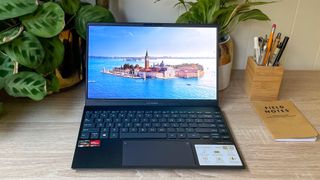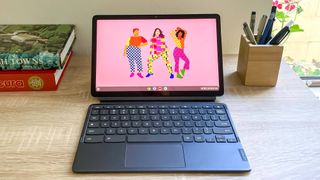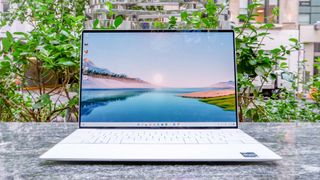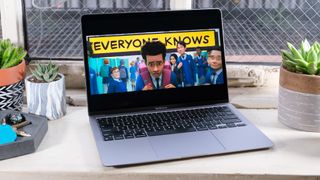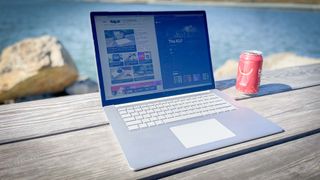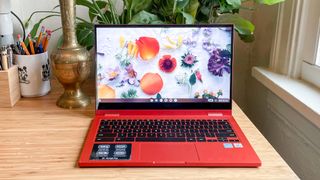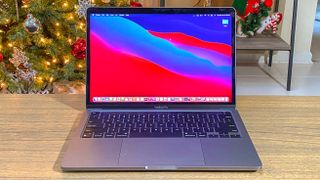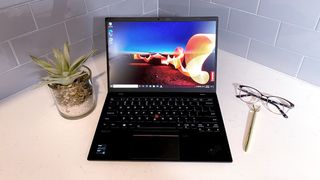The best laptops for college students are powerful enough to let you tackle all your school projects, with enough portability and power capacity to get you through a full day of classes. Whether you’re going back to school in person or attending classes remotely, having the right laptop is key.
Our best college laptop picks all share a few common traits. They have excellent battery life, which is crucial when running between classes on campus all day. These laptops are also affordable, with many models under $1000 — though we’ve also listed some higher-priced laptops that are great investments.
If you’re worried about spending over $1,000, know that our picks are made with your future in mind. The MacBook Pro isn’t cheap, for example, but mine has lasted for 8 years, which is enough time for undergrad and graduate school (or for applying to your first jobs out of college). Read on for our picks of the best college laptops you can buy right now.
The best laptops for college students
College students learning to make a dollar stretch can learn a lesson from the Acer Swift 3. That lesson? You don’t need to pay a premium for great performance. Its AMD Ryzen 7 4700U CPU is snappy and it’s got exceptional battery life (11:09) — all packed into a lightweight design. Plus, its USB Type-C, HDMI and USB-A ports mean you’re able to do more with any adapters or dongles.
On top of that, its keyboard is great for typing out term papers, with quiet, clicky keys that won’t irritate your roommate. Just don’t expect it to replace your Bluetooth speaker: we wish its audio had a bit more kick. Its slightly dim display isn’t great for Netflix either, but its mix of performance and price is so strong that you’ll be able to look past that minor concern.
Read our full Acer Swift 3 (AMD) review.
If you’re looking to spend between $500-$1,000 the AMD-equipped Asus Zenbook 13 OLED is an excellent value, offering an eye-catching 1080p OLED display and exceptional battery life in a slim, lightweight package for less than a thousand bucks.
Sure, the speakers aren’t amazing, the webcam leaves something to be desired, and there’s no headphone jack (though it does ship with an adapter), but these are stumbling blocks you can work around. If you need a zippy little ultraportable with a great screen that will last you through a full day of classes and then some, you can’t do better than the OLED-equipped Asus Zenbook 13 at this price.
Read our full Asus Zenbook 13 OLED review.
If your schoolwork can be handled with a Chromebook, the Lenovo Duet 3 (or Lenovo IdeaPad Duet 3, depending on where you buy it) is a great Chrome tablet that can be yours for as low as $359. This is effectively a bigger, more expensive follow-up to the Chromebook Duet Lenovo released in 2020, a surprisingly capable and inexpensive Chrome tablet.
We loved the original Duet for its great battery life, solid performance and decent packed-in keyboard cover, all of which could be had for roughly $250. Lenovo’s new Duet 3 costs a bit more, but it also delivers a bigger, brighter display, more ports, and the added power of a beefier Qualcomm Snapdragon 7c Gen 2 chip. It’s one of the best Chrome tablets you can buy, and the fact that Lenovo includes the keyboard cover at no extra cost helps it double as a surprisingly effective 2-in-1 Chromebook.
Read our full Lenovo Duet 3 Chromebook review.
Judging by the name, you might think that the Dell XPS 13 Plus is a bigger version of Dell’s iconic laptop. But it’s actually quite the opposite. This is as minimalist a design as we’ve ever seen from Dell.
There’s just two ports. There’s no headphone jack. And Dell even took away physical function keys, replacing them with a capacitive row. There’s not even lines to denmark the touchpad; the entire area beneath the keyboard is one smooth piece of glass.
But the XPS 13 Plus isn’t just a design statement. Dell managed to pack a 28W 12th gen Core i7 processor into this sleek 2.7-pound machine. And the result is a system that can outperform even the mighty MacBook Pro M2 on some tests. However, the short battery life and capacitive function row will give some pause. We also found the bottom gets a bit toasty when running at full power, so keep that in mind to avoid a scorched lap!
Read our full Dell XPS 13 Plus review.
Not interested in the Plus? Don’t miss our Dell XPS 13 OLED review — the base XPS 13 is still a great laptop that we recommend often.
The 2020 MacBook Air will keep its charge through multiple classes, breaks and all-nighters. We mean that, as it survived on the Tom’s Guide battery test for 14 hours and 41 minutes, the longest-lasting MacBook Air ever. Its performance is also seriously faster: the M1 chip makes the MacBook Air a shockingly decent system in multiple ways. Not only did it run Rise of the Tomb Raider smoothly, but that was a Rosetta 2 conversion of that Intel app.
Plus, you can run iOS and iPadOS apps on the MacBook Air, as its M1 processor is similar to the A-series iPhone and iPad processors. Living the remote learning life? You’ll look clearer and more accurate than ever, as signal processing in the M1 makes the MacBook Air webcam better than ever. Also, its Magic Keyboard is really great for typing comfortably for hours on end.
Read our full Apple MacBook Air M1 (late 2020) review.
The Surface Laptop 5 isn’t a bad device. The spacious keyboard and tall screen are great for getting work done, and the fact that Microsoft improved the brightness this time around makes the Surface Laptop 5 more usable outdoors than its predecessor. The newly-added Thunderbolt 4 support is also welcome, especially if you like to use external displays, and the upgrade to a 12th Gen Intel CPU delivers clear improvements in performance benchmarks.
But those are the only meaningful upgrades Microsoft appears to have delivered over last year’s model, and they don’t do enough to keep the Surface Laptop 5 competitive with some other laptops on the market. You can generally get better performance and more useful features for your money from competitors like the Acer Swift 5 and Dell XPS 15 OLED.
So while the Surface Laptop 5 is still a very serviceable laptop, it’s a disappointing step forward from Microsoft. This is the company that Windows built, and it would be great to see it take a leading role in designing the ideal Windows 11 laptop. It’s a decent enough productivity laptop, but it could have been better.
Read our full Microsoft Surface Laptop 5 review.
The original Samsung Galaxy Chromebook’s biggest perk was actually creating its achilles heel. Yes, that 4K OLED display was sharp, but a move to a 1080p QLED panel was a fantastic decision that should make this Chromebook a hit. Now it’s way more affordable, and also has better battery life— 7:50 vs the previous model’s 5:55. Of course, that’s still not nearly as good as the other laptops on this list, most of which lasted 10-16 hours on a single charge.
Plus, the Galaxy Chromebook 2 pumps out a ton of volume for such a small laptop. Admittedly, we weren’t as happy with the vertical travel in its keyboard, which creates a typing experience you may have to adapt to — unless you’re coming from a MacBook from 2016 to 2019. But college students will find a lot of value in a Chromebook that looks this good — its Fiesta Red color option will stand out in your lecture halls — and works this well.
Read our full Samsung Galaxy Chromebook 2 review.
College students looking for a portable 2-in-1 that can last a while should give the Surface Go 2 a close look. Yes, the original Surface Go was not a hit, but this model fixed practically everything wrong with the original. Its thinner bezels mean more screen space for your assignments (and a more modern looking tablet). We would have ranked the Surface Go 2 a bit higher, but its 10.5-inch screen and keyboard may be small for some college students.
And its battery life, just as importantly, is great: it lasted 11 hours and 39 minutes in our battery test, which is over 5 hours longer than the original Surface Go lasted. College students will love the Surface Go 2’s Zoom-ready webcam, a 5-megapixel 1080p front camera that is perfect for this era of online learning. Plus, you get Windows Hello biometric login for unlocking the Surface Go 2 when you sit down to it, and if you get the 8th Gen Intel Core i3 version, you’ll get the moderate multitasking capability you need to catch up with your coursework (while you stream Spotify).
Read our full Microsoft Surface Go 2 review.
If you’re going off to college to learn about making movies or master other visual media, you’ll want to turn to the M1-powered MacBook Pro. Its display is better than the Air’s and its battery lasts longer as well — it ran for 16 hours and 25 minutes in our battery test, which is absolutely epic. And once your favorite applications update to support Apple silicon, you’ll wonder what took Apple so long to ditch Intel.
And just like with the aforementioned Air, the MacBook Pro comes with the new Magic Keyboard, as Apple finally ditched the shallow and unreliable Butterfly keyboards. This combination of endurance and performance, mixed with a display that’s great for seeing your creations come to life makes for one of the best college laptops for Apple users, provided their budget allows for it.
If you prefer bigger screens, Apple just announced two new MacBook Pro models — one with a 14-inch screen and one with a 16-inch display. They’re not cheap, as the MacBook Pro 14-inch 2021 model starts at $1,999 and the MacBook Pro 16-inch 2021 goes for $2,499. But they do let you choose between very powerful M1 Pro and M1 Max chipsets, and that power figures to keep your MacBook humming for a very long time. Stay tuned for our full reviews of those new models.
Read our full MacBook Pro with M1 review.
If you absolutely, positively need the lightest laptop possible for going back to school, the Lenovo ThinkPad X1 Nano is a great choice. This svelte 2-pound laptop will be easy to carry and should last you through a full day at school; it lasted 12 hours on our battery test, which puts it up there against some of the very best laptops on the market today. And that’s quite impressive when you remember that the 2.9-pound XPS 13 is almost a whole pound heavier.
Lenovo didn’t sacrifice on performance or usability either. The Nano’s Intel 11th Gen Tiger Lake processors provide the speed you need for tackling your school projects, and its keyboard provides a snappy and comfortable typing experience that lives up to the ThinkPad brand. You just might need to pack a USB-C hub, though, as it’s a little light on ports.
Read our full Lenovo ThinkPad X1 Nano review.
How to choose the best college laptop for you
Portability and battery life are often more important than performance, screen quality, or any other attribute when you’re shopping for a laptop that’s great for school. Luckily we put every laptop we review through our Tom’s Guide battery test, which involves continuously browsing the web over Wi-Fi with the screen brightness set to 150 nits.
Based on those results, we recommend budget shoppers consider purchasing the Acer Aspire 5, Asus Chromebook Flip C434 and Microsoft Surface Go 2, as all come in at less than $600 — and that’s with the Surface Go 2’s Type Cover Keyboard (sold separately). Picking between these three is simple. If you prioritize performance, get the Aspire 5. Need a Chromebook? The Flip C434’s your next laptop. Want a tablet? Go get a Surface Go 2.
The next price tier of laptops, both under $700, has the Acer Swift 3 and the Google Pixelbook Go, which brings up an interesting choice. The Swift 3 is fast for its price tag, but its screen is not that bright. If you can do all your school work via Chrome and Android, the Pixelbook Go’s premium build and excellent screen are a solid combination.
Lastly, we get to the folks who can spend $1,000 or more. iPhone-using college students can get the MacBook Air if their majors don’t require demanding programs, or spend the extra $300 for the remarkably long-lasting MacBook Pro if they’re going to be living within Adobe’s applications. (The latest MacBook Pro models with updated Apple silicon really push the price skyward, but they promise the best performance from an Apple laptop.) The rest of the student body, who think the best college laptop has to be a PC, will decide based around performance and audio quality. The Dell XPS 13 has modern 11th Gen CPUs and Thunderbolt 4 (great for connecting an external monitor) but unimpressive sound, while Microsoft’s Surface Laptop 4 has great sound and a powerful 11th Gen Intel CPU, but no Thunderbolt 4 ports — just two USB ports, one USB-C and one USB-A.
How we test the best college laptops
College students, no matter the season (or year, for that matter) live in a highly mobile situation, where they’re going to want a laptop that can last a while on a single charge. That’s why we test laptops with our afore-mentioned web-surfing-based battery test, which involves setting each laptop’s display to 150 nits of brightness and measuring how long it can last while loading an endless stream of web pages.
On top of that, we test each laptop’s performance with a mix of every day usage, (opening tons of web browser tabs, streaming YouTube and move) and performance-measuring benchmarks such as Geekbench for the CPU and our own storage speed tests to see how fast these laptops can clone big blocks of data.
We measure each laptop’s display via the readings recorded by our light gun, one of two pieces of hardware (the other being our colorimeter) that we use to measure how bright a screen can get and how much of the sRGB color spectrum it can produce.
You can also read our guide to choosing what size of TV you should buy for your dorm room as you head off to college and you can read about how one of our editors thinks you should get a gaming laptop as your next work or college laptop.

